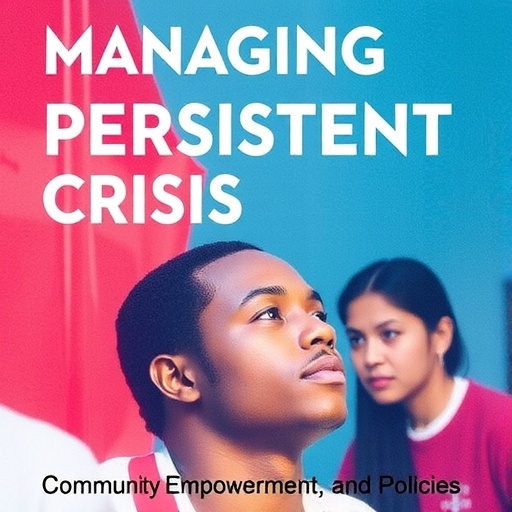
In an era characterized by escalating global uncertainties, the resilience of communities faces unprecedented tests. The recent study by Okada and Renn delves deeply into the labyrinthine challenges posed by persistent disruptive stressors and the phenomenon of polycrisis—simultaneous, interlinked crises that compound societal vulnerabilities. This research reveals how traditional top-down approaches to crisis management fall short, urging a paradigm shift toward community-based policymaking and local empowerment as the fulcrum for sustainable disaster risk reduction.
The notion of a “polycrisis” transcends the conventional understanding of isolated disasters, encapsulating the complex interplay of multifaceted stressors such as climate change, economic instability, social fragmentation, and public health emergencies. These intersecting pressures defy simple categorization or response and call for nuanced, integrative strategies capable of addressing their systemic complexity. Okada and Renn’s work offers a prescient analysis of how decentralized political and social structures can foster adaptive capacities to confront these compounded threats effectively.
Critical to their thesis is the identification of persistent disruptive stressors—long-duration, pervasive pressures that silently erode community resilience over time. Unlike acute catastrophic events, these stressors manifest as chronic social disruptions, prolonged environmental degradation, and persistent economic inequalities. Their insidious nature means they often escape immediate notice but cumulatively degrade the social fabric. The authors highlight the importance of recognizing and integrating these low-intensity, high-impact factors into risk assessment frameworks which traditionally prioritize discrete, large-scale disasters.
.adsslot_1z6pjRYxiJ{width:728px !important;height:90px !important;}
@media(max-width:1199px){ .adsslot_1z6pjRYxiJ{width:468px !important;height:60px !important;}
}
@media(max-width:767px){ .adsslot_1z6pjRYxiJ{width:320px !important;height:50px !important;}
}
ADVERTISEMENT
The study emphasizes that conventional centralized crisis governance models, which rely on expert-driven, hierarchical decision-making, are increasingly inadequate. These models struggle to accommodate the fluid dynamics and local nuances inherent in polycrisis scenarios. Instead, Okada and Renn advocate for a governance architecture oriented toward community-based policymaking. This involves active participation of local actors who possess contextual knowledge and vested interests in sustainable outcomes. Empowering communities to co-create policies ensures that responses are culturally sensitive, locally relevant, and socially equitable.
An essential technical dimension unpacked in the article is the role of social capital networks and trust-building mechanisms within communities. The authors argue that resilient communities exhibit dense, multifunctional social ties that facilitate information exchange, collective problem-solving, and mutual aid during crises. This sociological infrastructure underpins effective local governance and enhances capacity to absorb and transform under stress, ultimately fostering a more robust adaptive cycle.
Okada and Renn also scrutinize the dynamics of power distribution within community-based governance models. While local empowerment is central, they caution against idealizing grassroots movements without critically assessing underlying power asymmetries and elite capture risks. The research suggests the incorporation of transparent accountability mechanisms and inclusive deliberation processes to democratize decision-making genuinely and prevent co-option by narrow interests.
The authors present empirical case studies demonstrating successful instances of localized empowerment, especially in regions prone to simultaneous ecological and socio-economic shocks. These cases exhibit community-driven innovation in resource management, early warning systems, and social protection schemes. Such bottom-up initiatives exemplify how harnessing indigenous knowledge and social diversity can produce adaptive solutions that large-scale bureaucracies might overlook.
Furthermore, the paper argues for a reimagining of scientific expertise within polycrisis governance. It advocates for an intersectional epistemology that integrates diverse knowledge systems, including local and indigenous knowledges, community narratives, and transdisciplinary research. This pluralistic knowledge approach can bridge gaps between policy design and lived realities, enhancing legitimacy and uptake of resilience strategies.
Technologically, the study underscores the potential of digital platforms and participatory GIS (Geographic Information Systems) in enabling real-time community monitoring and collaborative policymaking. These tools empower marginalized voices by facilitating data democratization and transparent communication channels. However, the authors also highlight the digital divide as a critical barrier, urging investments in equitable access to digital infrastructure.
Importantly, the research situates community-based empowerment within broader systemic contexts, recognizing that local action must be supported by enabling environments at regional and national levels. Policy coherence, legal frameworks, and resource allocation are necessary to scale and sustain localized innovations. This multi-scalar governance perspective is crucial to address the entrenched structural drivers of vulnerability that local efforts alone cannot dismantle.
The study also reflects on the psychological dimensions of coping amidst persistent stressors. Chronic exposure to polycrisis conditions can erode collective morale and exacerbate social alienation. Interventions that strengthen social cohesion, nurture shared identities, and promote participatory ritual and commemorative practices can bolster emotional resilience and collective efficacy.
In sum, Okada and Renn’s work presents a compelling argument for reconceptualizing disaster risk management in the age of interconnected crises. Their evidence points toward an integrative framework that couples scientific rigor with democratic governance, technological innovation with social equity, and local agency with systemic support. This comprehensive approach is essential for building communities that not only survive but transform and thrive despite the relentless onslaught of modern-day polycrisis.
The implications extend beyond disaster risk science into broader policy domains, including urban planning, public health, and climate justice. Policymakers and practitioners are urged to embrace complexity rather than seek simplistic, siloed solutions. Investing in social infrastructure, fostering inclusive governance, and cultivating adaptive capacities at the grassroots can unleash transformative potentials for a resilient future.
As global challenges multiply and converge, this research serves as both a diagnostic lens and a hopeful manifesto. It challenges entrenched institutional paradigms and opens pathways for co-creative resilience, affirming that empowered communities are not merely victims but vital architects of their destinies amid persistent disruptive stressors and intertwined crises.
Subject of Research: Coping with persistent disruptive stressors and polycrisis through community-based policymaking and local empowerment.
Article Title: Coping with Persistent Disruptive Stressors and Polycrisis: Community-Based Policy Making and Local Empowerment.
Article References:
Okada, N., Renn, O. Coping with Persistent Disruptive Stressors and Polycrisis: Community-Based Policy Making and Local Empowerment. Int J Disaster Risk Sci (2025). https://doi.org/10.1007/s13753-025-00654-1
Image Credits: AI Generated
Tags: adaptive capacities for crisiscommunity resilience strategiescommunity-based policymakingcomplex societal vulnerabilitiesdecentralized political structureseconomic inequality challengesenvironmental degradation impactslocal empowerment policieslong-duration social disruptionspersistent disruptive stressorspolycrisis management approachessustainable disaster risk reduction





